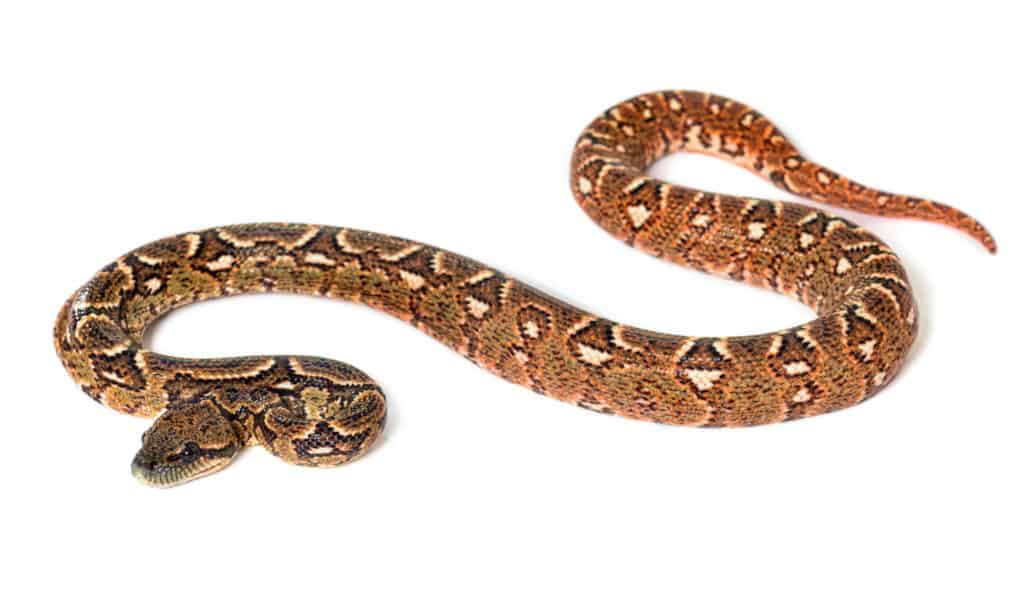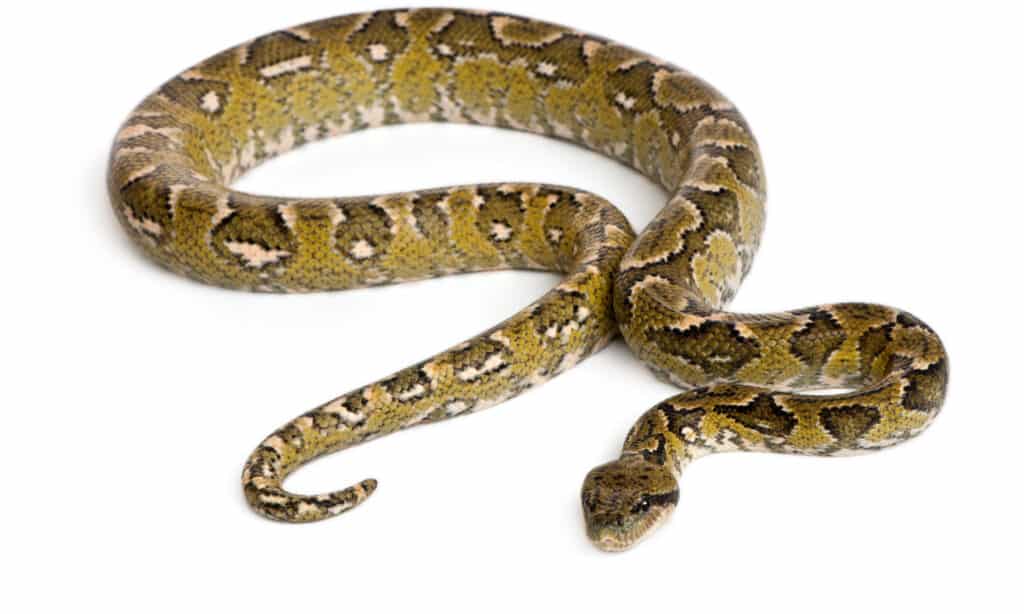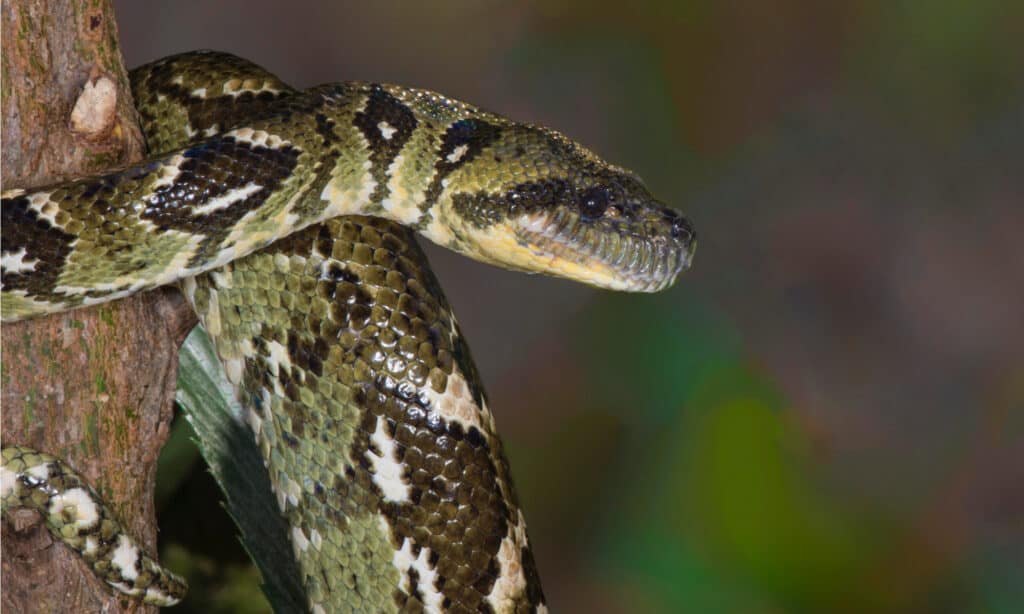Madagascar Tree Boa (original) (raw)
The Madagascar tree boa is a beautiful nonvenomous snake that is born with a bright red base color that changes to green as it matures. This medium-sized boa sleeps in the trees and eats a variety of rodents, small mammals, birds, lizards, and eggs.
3 Amazing Facts About Madagascar Tree Boas
- When a female is pregnant, she becomes so dark she is almost black.
- It has adapted very well to human encroachment and lives in the gardens and farms where it finds shrubs and trees in which to rest.
- They change color from red to green as they mature.
Where to find Madagascar Tree Boas
Only on the island of Madagascar. It’s not strictly arboreal, as their name implies, however. This snake spends a fair amount of time on the ground, hunting for its next meal. Madagascar boasts two genera of boa – Sanzinia, and Acrantophis. Unlike the Acrantophis genus, the Madagascar tree boa (S. madagascariensis) spends more time in the trees, hence, its tree boa moniker.
They mostly use trees for resting, so during the day, you’ll often find one curled up around a branch. At night, they wake up and begin their search for a meal. and hunting on the ground. This boa prefers forests with trees and shrubs growing close to rivers, streams, and swamps, avoiding arid parts of the island.
Madagascar Tree Boa’s Scientific Name
This snake is also called the boa manditra and the Malagasy tree boa, but it’s known to scientists as Sanzinia madagascariensis. The origin of the Madagascar tree boa’s genus name is a little fuzzy. It may be named after Victor Sganzin, who traveled to Madagascar in the 1830s and described several species he found on the island, but no one is certain. The specific epithet, madagascariensis, refers to its home of Madagascar.
There are two species within the Sanzinia genus; this one and the Nosy Komba ground boa (S. volontany). Until recently, it was considered a subspecies of S. madagascariensis. The Nosy Komba ground boa is more brownish in color and inhabits the western side of the island.
Population and Conservation Status of Madagascar Tree Boas
In 1996, the IUCN classified Madagascar tree boas as vulnerable, due to widespread habitat destruction, pet trade collection, and mining. Researchers found that many had been collected for the pet trade and as little as 20% of its original habitat remained; it was therefore deemed vulnerable to extinction in the wild.
The IUCN reassessed the species in 2011; they found that while it’s true that the island has seen a lot of ecologic change and damage, the boa adapted quickly. It began taking up residence in neighborhoods in gardens and rural communities where it found trees and shrubs in which to hide. Where other animals struggled, it thrived. They now list this species as Least Concern because it’s common throughout its range, with a stable population.
Identifying Madagascar Tree Boas: Appearance and Description
This medium-sized boa reaches about 4-5 feet long at maturity but can grow up to 6 feet long. It has smooth, glossy scales that aren’t keeled or ridged. The species has razor-sharp teeth that help it hold its prey while wrapping around and constricting it. The boa has either a bright red or greenish base color overlayed with darker markings that often have lighter centers. It has a dark stripe extending from in front of or just behind its eye diagonally towards the back of its head.
Like many other boas, it has elliptical pupils and heat-sensing organs between the scales of its lip. The thermoreceptors help them locate warm-blooded prey at night. This boa eats a variety of small prey items, including rodents, mouse lemurs, and other small mammals. However, the occasional frog or bird isn’t turned down either.
During the rainy season, Madagascar tree boas look for a mate. Males wrestle other males to chase them off so they can mate with a female. Females are often larger than males; when they are pregnant, the female’s color darkens, becoming almost black in places. The darker color helps moms collect more heat to help the babies’ development; after about 5-7 months, she gives birth to about 4-12 babies that immediately look after themselves.
When it’s born, a juvenile Madagascar tree boa measures about 15 inches long and has a bright red base color with darker markings. As it matures, the red becomes green. Many scientists believe the bright color mimics the coloring of venomous animals is a form of mimicry to protect the young from predation.

Malagasy tree boas are born with a bright red base color that changes to greenish as they mature.
©Eric Isselee/Shutterstock.com
Pictures and Videos of Madagascar Tree Boas

Madagascar tree boas become greenish as adults.
©Eric Isselee/Shutterstock.com

A Madagascar tree boa has thermo-receptive pits between its lip scales.
©imagebroker.com/Shutterstock.com
How Dangerous are Madagascar Tree Boas
Reptile keepers breed them as pets, and the people who keep them say that once the juveniles figure out that you’re not going to hurt them, they’re pretty easy to handle. They’re not dangerous at all and are excellent pest control. As a rule, snakes are fabulous to have around because they eat the mice and rats that follow human civilization. However, wild Madagascar tree boas are prone to biting when cornered.
Madagascar Tree Boa Behavior and Humans
Being nocturnal, if you live on the island of Madagascar, you’ll probably never see one unless you’re out looking for it at night. This boa sleeps in the trees and shrubs in its environment and hunts on the ground at night.
This snake is one of the few that seems to have adapted well to the changes that people bring to an environment. Having had the boa on the Vulnerable list for several years helped, as did CITES by placing it on the Appendix I list restricting international trade. Prior to its being listed by CITES in Appendix I, it was exported for the pet trade and is becoming a popular pet.
The Madagascar tree boa is non-venomous and not aggressive. It is shy a helper that tries to stay out of your way while it tracks down a meal or a mate.
View all 266 animals that start with M
Not at all! They are nonvenomous rodent hunters.
Madagascar tree boas prefer mouse lemurs, rats, and other small mammals but will also eat lizards and birds.
They’re nocturnal predators, have elliptical pupils to help with night vision, and have heat-sensing pits between their labial scales.
You’ll only find these snakes on the island of Madagascar.